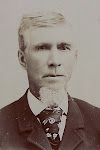St. Paul’s Episcopal Church &
Early Dukelow / Ducklow Family Connections
[Updated Nov. 26, 2008]
Early Dukelow / Ducklow Family Connections
[Updated Nov. 26, 2008]
St. Paul’s Episcopal Church in Ashippun Township of Dodge County has an integral history with the Thomas and Elizabeth Ducklow / Dukelow family. The existing church building, built between 1899-1900, lies about two miles south of the original Ducklow homestead. The roots of the church’s history go back some 50 years prior.
The very beginning of St. Paul’s history apparently starts in February of 1847. This is when Reverend Gustaf Unonius (a Norwegian itinerant pastor) began to minister to a few pioneer families that he called the “Irish settlement at Ashippun River.” The list of families that he noted in church records were:
Henry Johnson family
Samuel Johnson family
Richard Copithorn family
and the
Thomas Sanford family
Samuel Johnson family
Richard Copithorn family
and the
Thomas Sanford family
Above: St. Paul's Episcopal Church - A very handsome building
Church cemetery in background
Photo from Jeff Ducklow Collection; September 2007
Ashippun Township, Dodge County, Wisconsin
What is significant to the Ducklow genealogy regarding Reverend Unonius’ list is that both Henry and Samuel Johnson were Thomas’ step-uncles [see footnote]. To be more precise, they were brothers to Thomas’ stepmother—Nancy Ann Johnson Dukelow. Thomas’ mother Elizabeth died when Thomas was less than ten years old. So Nancy Ann was very likely became a nurturing mother to him during his remaining childhood and early adult years in Ireland.
So Thomas’ step-uncles are considered the first ministered members of what grew into St. Paul’s congregation.
Had the traveling Reverend Unonius made his list just few months later, it very likely would have also included the Thomas and Elizabeth Dukelow family. The land grant date for Thomas’ homestead is August 25, 1847 just a few months after the Reverend's list was written. Considering the date of Rev. Unonius' list and the date of land grant suggests that Thomas and Elizabeth had come to Wisconsin shortly after Thomas’ step-uncles had first found land to claim as homesteads in Ashippun Township.
Also noteworthy regarding the Reverend’s list is Samuel Johnson’s wife, Bettie Copithorn. It seems very likely that Bettie was either a sister or daughter to the Richard Copithorn on the list. The Johnson and Copithorn families were certainly more than casual acquaintances as one might first think.
The links back to the deep roots of St. Paul’s occurs again when Thomas and Elizabeth’s son William Ducklow married Mary Jane Miles in 1883. Some twenty five to thirty years earlier, Mary Jane’s father George Miles was the original benefactor of land for St. Paul’s church and cemetery.
St. Paul’s building seen in the photo above was originally consecrated on June 5, 1900. The officiating minister was the Reverend Isaac Lea Nicholson. It may be just simple coincidence, but Elizabeth Dukelow / Ducklow's maiden name was Nicholson. Was the Reverend Nicholson a relative of Elizabeth's?... Another mystery worth pursuing in the future.
From the pioneer days of the mid 1840s through the early 1910s St. Paul’s Episcopal Church served as the spiritual, worship, and fellowship focus for Thomas and Elizabeth and their family. All ten of Thomas and Elizabeth’s children born in Wisconsin were baptized there [the first four were baptized in New York state]. Son Peter wed Helena Timmel there. And upon their deaths, Thomas and Elizabeth, daughters Francis and Lucinda, and sons Thomas and William were laid to final rest in St. Paul's cemetery [see footnote].
❧
Source: Ashippun Township History, Clayton Swanton, pages 93-94.
Source: Interview with Clayton Swanton, October 2007 and November 2008
Footnote: The Johnson / Dukelow genealogy source information in this post comes from research records shared by Grant Dukelow Brown. Mr. Brown’s research has been scrupulously accurate when compared to other sources. However this specific relationship that defines Henry and Samuel as Thomas’ step-uncles has yet to be independently verified.
Footnote: St. Paul’s and another area church, St. Olaf’s, have a complex and inter-twined early history. St. Paul's and St. Olaf's lie just a couple of miles apart and both congregations formed in the mid 1800s. Without going into too much detail, it appears that both churches served the Norwegian’s and Irish of the area and either church could have become an Episcopal or Lutheran congregations, but St. Olaf’s eventually called a Lutheran pastor and St. Paul’s became associated with the Episcopal church.
Because the early church congregations were inter-twined and St. Olaf’s had started a cemetery, it is likely that Thomas and Elizabeth’s three infant children are buried in unmarked graves in the St. Olaf’s cemetery before St. Paul’s cemetery existed. St. Olaf’s seems the most likely location for daughters “infant” Elizabeth and “infant” Marie Jane. Infant son George died when the St. Olaf’s cemetery was just started. He may be in an unmarked grave there, or somewhat more likely due to the date of his death, he is buried in an unmarked grave in another burial area a couple miles away. This area was called the “Gasman Cemetery" or "Gasman Burial Grounds.” It never became a frequently used burial place after the St. Olaf’s cemetery was started. And some of the burials in Gasman were moved to St. Olaf's cemetery, but not all, and no records are known of to clarify. Today the Gasman burial grounds are used as a cornfield. The farmer is apparently unaware or blind to the sacred nature of the field. It appears impossible to determine with certainly for lack of records or grave markers where Thomas and Elizabeth's infant children are actually buried.
❦



No comments:
Post a Comment